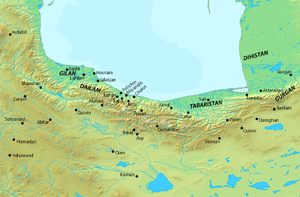Sayyida Shirin
Sayyida Shirin (Persian: سیده ملک خاتون), also known simply as Sayyida, was a Bavandid princess, who was the wife of Buyid ruler of Ray, Fakhr al-Dawla.
Origins

According to the medieval historian Hilal al-Sabi' and the modern historian Madelung, Sayyida Shirin was the sister of the Bavandid ruler Al-Marzuban.[1] However, according to the Qabus-nama made by the Ziyarid ruler Keikavus (who was a neighbor of the Bavandids and of Bavandid descent himself), Sayyida Shirin was the niece of Al-Marzuban.[1] Hugh N. Kennedy calls her the son of a certain Bavandid ruler (ispahbadh) of Tabaristan named Sharwin, who may be the Bavandid ruler Sharwin III, who was the brother of Al-Marzuban. Sayyida Shirin also had a brother named Rustam Dushmanziyar,[2][3] whose son Muhammad ibn Rustam Dushmanziyar became the founder of the Kakuyid dynasty. Although Sayyida is called a Kurd in some sources,[4] she is generally agreed to be from the Bavand dynasty,[3][1][5] which was of Dailamite origin.[3] Encyclopædia Iranica also states that; “it should be remembered that “Kurd” in the sources of the 10th-11th centuries refers to all the transhumants of the Zagros region including the Lors.”[6]
Biography
At an unknown date, Sayyida Shirin married Fakhr al-Dawla, and bore him two sons named Abu Taleb Rostam and Abu Taher in the 990s. Fakhr al-Dawla later died in 997 and was in Ray succeeded by Abu Taleb Rostam, who was given the laqab of "Majd al-Dawla". Meanwhile, Abu Taher was given the laqab of "Shams al-Dawla", and became the ruler of Hamadan. Since both brothers were in the age of minority, power was assumed by Sayyida. Both sons initially declared themselves independent and assumed the title of Shâhanshâh, but by 1009 or 1010 at the latest had recognized the authority of their relative Baha' al-Dawla, who controlled Fars and Iraq, and abandoned the title.
In 1006 or 1007, with the assistance of his vizier Abu 'Ali ibn 'Ali, Majd al-Dawla attempted to throw off the regency of Sayyida. Sayyida, however, escaped to the Kurd Abu Najr Badr ibn Hasanuya, and together with Shams al-Dawla they put Ray under siege. After several battles, the city was taken and Majd al-Dawla was captured. He was imprisoned by Sayyida in the fort of Tabarak, while Shams al-Dawla took to power in Ray. After a year, Majd al-Dawla was released and reinstated in Ray; Shams al-Dawla returned to Hamadan. Power continued to be held by his mother. However, Shams al-Dawla later tried to seize Ray from Majd al-Dawla, but was stopped by Sayyida. Sayyida later died in 1028.[7]
References
- ↑ 1.0 1.1 1.2 Madelung 1975, p. 217.
- ↑ Huart 1993, p. 667-668.
- ↑ 3.0 3.1 3.2 Kennedy 2004, p. 244.
- ↑ Meisami 1999, p. 200.
- ↑ Madelung 1984, pp. 747-753.
- ↑ Ch. Bürgel & R. Mottahedeh 1988, pp. 265-269.
- ↑ Bosworth 1975, p. 177.
Sources
- Bosworth, C. E. (1975). "Iran under the Buyids". In Frye, R. N. The Cambridge History of Iran, Volume 4: From the Arab Invasion to the Saljuqs. Cambridge: Cambridge University Press. pp. 250–305. ISBN 0-521-20093-8.
- Nagel, Tilman (1990). "BUYIDS". Encyclopaedia Iranica, Vol. IV, Fasc. 6. London u.a.: Routledge & Kegan Paul. pp. 578–586.
- Kennedy, Hugh N. (2004). The Prophet and the Age of the Caliphates: The Islamic Near East from the 6th to the 11th Century (Second ed.). Harlow, UK: Pearson Education Ltd. ISBN 0-582-40525-4.
- Madelung, W. (1975). "The Minor Dynasties of Northern Iran". In Frye, R.N. The Cambridge History of Iran, Volume 4: From the Arab Invasion to the Saljuqs. Cambridge: Cambridge University Press. pp. 198–249. ISBN 978-0-521-20093-6.
- Madelung, W. (1984). "ĀL-E BĀVAND (BAVANDIDS)". Encyclopaedia Iranica, Vol. I, Fasc. 7. London u.a.: Routledge & Kegan Paul. pp. 747–753. ISBN 90-04-08114-3.
- Frye, R. N. (1986). "Bāwand". The Encyclopedia of Islam, New Edition, Volume I: A–B. Leiden and New York: BRILL. p. 1110. ISBN 90-04-08114-3.
- Bosworth, C. E. (1975). "The early Ghaznavids". In Frye, R. N. The Cambridge History of Iran, Volume 4: From the Arab Invasion to the Saljuqs. Cambridge: Cambridge University Press. pp. 162–198. ISBN 0-521-20093-8.
- Huart, CL. (1993). "Kākōyids". E.J. Brill's First Encyclopaedia of Islam, Volume IIII. Leiden: BRILL. p. 667-668. ISBN 9789004097902.
- Meisami, Julie Scott (1999). Persian Historiography to the End of the Twelfth Century. Edinburgh University Press. pp. 1–319. ISBN 9780748612765.
- Ch. Bürgel; R. Mottahedeh (1988). "ʿAŻOD-AL-DAWLA, ABŪ ŠOJĀʾ FANNĀ ḴOSROW". Encyclopaedia Iranica, Vol. III, Fasc. 3. London u.a.: Routledge & Kegan Paul. pp. 265–269.